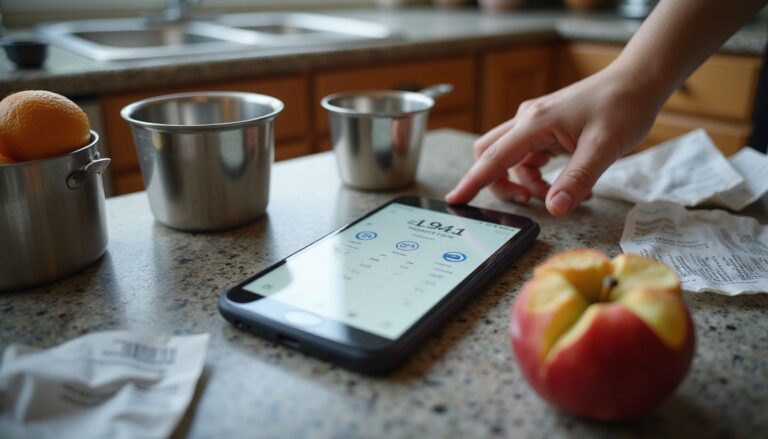7-Day Low Calorie Meal Plan: Expert Dietitian’s Menu For A Healthy Diet
Our Nutrition Assistant AI Suite will transform your body. You will lose fat, get toned, and build muscle. Gain confidence and optimal health.
You want to lose weight or simply eat better, but the internet is noisy. A structured low-calorie meal plan cuts through that noise and gives you clear steps. Research shows that reducing daily calories while keeping meals balanced can support safe weight loss and better health.
Below, you will find a simple 7-day menu created with dietitian guidance. It includes quick meals, portion reminders, and a short list of foods to emphasize or limit. Start your healthy week today.
Key Takeaways
- A 7-day low-calorie plan often targets 1,200 to 1,500 calories for women and 1,500 to 1,800 for men to promote weight loss (Harvard T.H. Chan School of Public Health).
- Menus built around lean protein, whole grains, fruits, and vegetables help control hunger while covering key nutrients.
- Losing about 1 to 2 pounds per week is considered safe when you reduce calories and choose meals rich in fiber and protein (Slavin JL, 2013).
- Measuring portions with cups and spoons improves accuracy and long-term weight control compared to guessing (Harvard T.H. Chan Nutrition Source).
- Plan with nutrient-dense foods like salmon, yogurt, berries, leafy greens, quinoa, sweet potatoes, and olive oil for better results.

What is a Low-Calorie Diet?

A low-calorie diet usually means 1,200 to 1,500 calories per day for women and 1,500 to 1,800 for men. That range supports weight loss while leaving room for nutrients your body needs.
Build your plate with protein and fiber. Good examples include chicken breast, bean salad, brown rice, kale, spinach, and oats. Protein and fiber help you feel full so you can cut calories without feeling deprived.
Limit fast food and sugary drinks like soda. Swap heavy sides, such as buttery potatoes, for roasted vegetables like broccoli or cauliflower. Pair them with lean protein, such as grilled chicken or shrimp. Portion control matters. Measuring with simple tools keeps you inside your goal.
Replacing one soda a day with water trims over 50 grams of added sugar, close to 200 calories, says a registered dietitian.
Plans that focus on nutrient-dense foods work better than strict restriction alone. You develop steady meal habits and reach for fruit or nuts instead of candy or ice cream.
Benefits of a 7-Day Low-Calorie Meal Plan
A 7-day low-calorie meal plan can help you lose weight while building daily habits that last. Meals that combine protein, fiber, and healthy fats tend to boost energy and keep you satisfied.
How does it support weight loss?
Weight loss happens when you create a calorie deficit, which means you burn more energy than you eat. You can safely average 1 to 2 pounds lost per week with a calorie target that fits your body and activity level. Choose whole grains, vegetables, and lean protein to make that deficit feel easier to maintain https://www.hsph.harvard.edu/nutritionsource/healthy-weight/diet-reviews/calorie-counting/.
Portion control reduces overeating. Fiber-rich foods, such as vegetable soup and black bean salad, help you stay full longer. Swapping higher calorie sides for lighter, low-fat recipes keeps flavor on your plate with fewer calories. Planning menus in advance makes daily targets realistic.
How does it improve overall health?
Low-calorie plans that highlight vegetables, fruits, whole grains, legumes, nuts, and lean proteins offer vitamins, minerals, and fiber. Fiber helps control blood sugar and supports healthy cholesterol levels. A nutritious pattern may also lower the risk of certain cancers linked with obesity.
Eating balanced meals supports steady energy during exercise and daily tasks. Small shifts, like trading refined grains for whole grains, can improve health markers over time.
Balanced nutrition is one of the easiest ways to protect yourself against chronic illnesses.
References
- Slavin JL, 2013, Dietary fiber and body weight regulation.
- World Cancer Research Fund/AICR, 2018, Diet, Nutrition, Physical Activity and Breast Cancer.
- Aune D et al., BMJ 2015;351:h3978, fiber intake and endometrial cancer risk.
- Westerterp KR, 2009, energy expenditure measurement in obesity management programs.
How does it help maintain portion control?
A 7-day plan sets clear serving sizes for each meal and snack. Using cups, spoons, or a small kitchen scale removes guesswork. Prepping grab-and-go items, like snack bags of berries or single-serve cottage cheese, keeps portions steady during busy days.
A detailed menu makes portions predictable from breakfast to dinner. For example, lunch might be cottage cheese with sliced tomato or a lettuce wrap with roasted peppers. Tracking intake helps you spot high-calorie foods that can lead to weight gain. People who measure portions tend to have better weight outcomes than those who estimate.
How does it encourage balanced nutrition?
Portion awareness helps you see each ingredient’s role. A balanced plate usually includes vegetables, lean proteins, whole grains, and healthy fats from items like avocado, nuts, seeds, or olive oil. This mix supplies protein, fiber, vitamins, and minerals so you feel satisfied.
Choose cooking methods that protect nutrients, such as roasting, baking, or grilling. Swapping creamy sauces for herbs, salsa, or citrus keeps flavor high and calories low.
How to Prepare for a Low-Calorie Meal Plan
A little setup makes the week easier. Stock your kitchen, set goals you can reach, and map out meals you can cook in your schedule.
How do you set realistic goals?
Decide what you want this week to accomplish. Examples include keeping daily calories under a set number, losing a few pounds, or eating breakfast every day. Make goals specific and time bound, then track them in a journal or app.
Choose small steps if big ones feel hard. Switch soda for water. Bake or grill instead of fry. Add at least one vegetable to each meal. Simple, steady changes add up and are easier to keep.
What healthy ingredients should you stock up on?
Fill your cart with these basics so meals come together fast:
- Vegetables: spinach, bell peppers, broccoli, cauliflower, leafy greens.
- Protein: chicken breast, tofu, turkey, canned salmon, eggs, beans, lentils.
- Smart carbs: quinoa, brown rice, oats, whole-wheat bread or tortillas.
- Fruits: berries, apples, oranges, bananas.
- Flavor helpers: salsa, low-sodium broth, lemon, garlic, spices like cumin and paprika.
- Healthy fats: olive oil, avocado, nuts, seeds, nut butter.
Frozen vegetables are useful for busy nights. They cook quickly and help you skip less healthy convenience food.
How can you plan your meals in advance?
Pick simple recipes that fit your calorie goals and your calendar. Build a shopping list from those choices. Prep a few staples in bulk, such as cooked grains, roasted vegetables, or grilled chicken. Portion them into containers for grab-and-go meals.
Planning limits last-minute choices that often add calories. It also helps you hit targets from day 1 through day 7.
7-Day Low-Calorie Meal Plan: Daily Menus
Use these daily menus as a guide. You can swap similar foods to match taste or season, while keeping portions steady.
Day 1:
Breakfast: plain Greek yogurt with fresh berries and one tablespoon chia seeds, about 180 calories. Protein keeps you full, while berries deliver antioxidants.
Lunch: large salad with leafy greens, cherry tomatoes, grilled chicken breast, and half an avocado. Dress with lemon and a small splash of olive oil, about 300 calories.
Dinner: baked salmon with steamed broccoli and roasted sweet potato, about 350 calories. This meal offers healthy fats that support heart health.
Choose water or unsweetened tea to stay on target.
What should you eat for breakfast on Day 1?
Cook old-fashioned oats with water or skim milk. Top with half a banana and five sliced almonds. Add one boiled egg for extra protein. Aim for under 300 calories. Tea or water gives hydration without sugar.
What is a healthy lunch option for Day 1?
Make a grilled chicken salad with mixed greens, cherry tomatoes, cucumber, and shredded carrots. Use a light vinaigrette or lemon juice. Add a small whole-grain roll. This meal is about 350 calories with around 30 grams of protein, which helps manage afternoon hunger.
What is a nutritious dinner for Day 1?
Choose grilled salmon with steamed broccoli and half a cup of roasted sweet potato. Use one teaspoon of olive oil for flavor. Expect roughly 350 to 400 calories, solid protein, and at least five grams of fiber.
Day 2:
Breakfast: whole-grain toast with mashed avocado and a poached egg, plus half a grapefruit, about 280 calories.
Lunch: salad with mixed greens, grilled chicken breast, cherry tomatoes, cucumber, and two tablespoons balsamic vinaigrette, about 320 calories. Add an apple for a snack.
Dinner: baked cod with lemon and herbs, steamed broccoli, and half a cup of brown rice, about 350 calories. The protein supports muscle while you lose weight.
What should you eat for breakfast on Day 2?
Plain Greek yogurt with half a cup of blueberries and one tablespoon sliced almonds. Add a slice of whole-grain toast if you need extra energy. Water or herbal tea keeps the meal light and hydrating.
What is a healthy lunch option for Day 2?
Grilled chicken salad with mixed greens, cherry tomatoes, cucumber, and a light vinaigrette. Add half an avocado or a sprinkle of sunflower seeds for texture. Use about 4 ounces of chicken to manage calories. Expect 300 to 350 calories and steady energy.
What is a nutritious dinner for Day 2?
Grill or bake salmon, then serve with steamed broccoli and half a cup of cooked quinoa. Add one teaspoon olive oil for flavor. Keep the plate under 450 calories. This balance of lean protein, healthy fat, and fiber supports heart health and portion control.
Day 3:
Breakfast: Greek yogurt with sliced strawberries and a spoonful of chia seeds. Aim for about 20 grams of protein to start your day strong.
Lunch: spinach salad topped with grilled chicken breast, cherry tomatoes, cucumbers, shredded carrots, and one tablespoon vinaigrette. This keeps calories low but nutrients high.
Dinner: roasted salmon, steamed broccoli, and half a baked sweet potato for fiber and healthy fats. Fish supports brain and heart health across ages.
What should you eat for breakfast on Day 3?
Have Greek yogurt with fresh blueberries and one tablespoon chia seeds, about 180 calories and 17 grams of protein. Add half a slice of whole-grain toast for a gentle boost of carbs.
What is a healthy lunch option for Day 3?
Use a whole-grain wrap with grilled chicken, spinach, and tomato. Spread a thin layer of hummus. Add carrot sticks and a small apple. Expect about 350 to 400 calories and a filling mix of protein and fiber.
What is a nutritious dinner for Day 3?
Prepare grilled salmon with steamed broccoli and roasted sweet potatoes. A 4-ounce portion of fish with half-cup sides lands near 400 to 450 calories. Use olive oil lightly to keep calories in check.
Day 4:
Breakfast: plain Greek yogurt with fresh berries and one tablespoon chia seeds, about 180 calories with protein and calcium.
Lunch: grain bowl with half a cup brown rice, grilled chicken breast, diced cucumber, cherry tomatoes, and leafy greens. Add two teaspoons olive oil. Expect around 350 calories.
Dinner: grill 4 ounces salmon or tofu with steamed broccoli and cauliflower. Use lemon instead of salty sauces to keep dinner under 400 calories.
What should you eat for breakfast on Day 4?
Plain Greek yogurt with half a cup blueberries and one tablespoon chia seeds. Pair with one slice of whole-wheat toast for complex carbs. This combo supports fullness through the morning.
What is a healthy lunch option for Day 4?
Make a whole-wheat wrap with 3 ounces grilled chicken, spinach, sliced tomatoes, shredded carrots, and cucumber strips. Add a light Greek yogurt dressing. A side salad boosts fiber with minimal calories.
What is a nutritious dinner for Day 4?
Bake a 4-ounce salmon fillet. Serve with one cup roasted Brussels sprouts and half a cup quinoa. Finish with fresh lemon. The plate sits near 400 calories and supports heart health.
Day 5:
Breakfast: Greek yogurt with sliced strawberries and a sprinkle of chia seeds for protein and fiber.
Lunch: lentil soup with whole-grain crackers and raw carrot sticks. Lentils bring plant protein and slow-digesting carbs.
Dinner: grilled salmon over quinoa with steamed broccoli. Drink water or unsweetened tea to stay hydrated without extra calories.
What should you eat for breakfast on Day 5?
Plain Greek yogurt with half a cup sliced strawberries and one tablespoon chia seeds. Add one slice of whole-grain toast. Keep it under 300 calories for a steady start.
What is a healthy lunch option for Day 5?
Whole-grain wrap with grilled chicken, leafy greens, shredded carrots, cucumber, and a tablespoon hummus, about 320 calories. Add a small apple to bring lunch near 380 calories with fiber and vitamins.
What is a nutritious dinner for Day 5?
Grilled salmon with half a cup cooked quinoa and steamed green beans. Flavor with lemon and herbs. Keep portions modest to manage calories while getting protein, iron, and vitamins.
Day 6:
Breakfast: spinach and mushroom omelet cooked in a small amount of olive oil. Add half a grapefruit for vitamin C.
Lunch: grilled shrimp on a garden salad with cherry tomatoes, cucumber, and mixed greens. Use lemon juice for dressing.
Dinner: baked turkey breast with roasted asparagus and quinoa. Drink water through the day to support hydration.
What should you eat for breakfast on Day 6?
Plain Greek yogurt with half a cup blueberries and one tablespoon chia seeds, about 180 calories. Add two boiled eggs for extra protein if needed. Choose water or unsweetened green tea.
What is a healthy lunch option for Day 6?
Grilled turkey breast with roasted sweet potato and steamed broccoli. A 3-ounce portion of turkey provides about 25 grams of protein. Add herbs or lemon for flavor instead of extra salt.
What is a nutritious dinner for Day 6?
Bake a salmon fillet and serve with steamed broccoli and quinoa. Drizzle a tablespoon of extra-virgin olive oil over the vegetables. Expect about 420 calories with plenty of protein and fiber.
Day 7:
Breakfast: steel-cut oatmeal with sliced banana and cinnamon. This combo offers fiber and steady energy.
Lunch: grilled chicken breast over mixed greens with cherry tomatoes, cucumber, and balsamic vinaigrette. Fresh vegetables add crunch, and protein helps control hunger.
Dinner: baked cod with roasted Brussels sprouts and quinoa. Add a small apple between meals if you need a snack.
Many people find that simple, repeatable meals reduce stress and keep progress steady.
What should you eat for breakfast on Day 7?
Scramble one egg with baby spinach and chopped tomatoes in a nonstick pan. Serve with one slice whole-grain toast and half an avocado. Add unsweetened green tea for antioxidants.
What is a healthy lunch option for Day 7?
Grilled chicken with quinoa salad. Add cherry tomatoes, chopped cucumbers, and parsley. Dress with one tablespoon olive oil and lemon juice for a light finish.
What is a nutritious dinner for Day 7?
Bake salmon and pair with steamed broccoli and brown rice. Top with lemon or dill for flavor. One serving runs about 400 to 450 calories and delivers protein, fiber, and key vitamins.
Tips for Sticking to a Low-Calorie Diet
Small habits make big changes possible. Use these strategies to keep your plan on track.
How can you stay hydrated on a low-calorie diet?
Drink water during the day. Aim for about eight cups unless your clinician advises otherwise. Choose water, herbal tea, or sparkling water with lemon instead of sugary drinks.
High-water foods like cucumbers, lettuce, oranges, and strawberries help too. Keeping a refillable bottle nearby makes it easy to sip and avoid unnecessary snacks.
Why should you avoid sugary drinks?
Sugary drinks add calories fast. A 12-ounce soda has about 150 calories and around 40 grams of sugar. Frequent intake can raise blood sugar and increase the risk for type 2 diabetes and heart disease.
Choosing water, tea, or flavored seltzer supports your goals. Many people notice more stable energy once they switch away from soda.
Why is it important not to skip meals?
Skipping meals can slow metabolism and trigger headaches or irritability. It also increases the chance of overeating later. Eating on a regular schedule supports appetite control and better nutrition.
Plan three meals and, if needed, one small snack. Balanced, predictable eating patterns make it easier to stay within your calorie target.
How can you practice mindful eating?
Eat more slowly and pay attention to taste and texture. Put your fork down between bites. Studies suggest mindful eating can reduce calorie intake compared with distracted eating.
Turn off screens at meals. Use smaller plates to guide portions. Mindful eating and hydration work well together to support your plan.
Conclusion
A 7-day low calorie meal plan gives you structure, balanced nutrition, and clear portion sizes. You get protein, fiber, and healthy fats in each meal so you feel satisfied while losing weight. With a short shopping list and simple prep, you can stay consistent and build habits that last.
Health note: if you have a medical condition, take medications, are pregnant, or have a history of disordered eating, talk with a registered dietitian or healthcare professional before starting any diet.
FAQs
1. What is a 7-day low calorie meal plan and how does it support a healthy diet?
A 7-day low calorie meal plan provides structured menus for one week, focusing on nutrient-rich foods with reduced calories. This approach helps manage weight while ensuring the body receives essential vitamins and minerals. Research shows that following such plans can improve metabolic health and promote steady weight loss when combined with regular activity.
2. How many calories are typically included in an expert dietitian’s menu for this type of plan?
Most expert dietitians recommend daily intake between 1200 to 1500 calories for women and 1500 to 1800 calories for men, depending on age, size, and activity level. These values align with guidelines from the Academy of Nutrition and Dietetics which suggest safe calorie ranges to maintain energy balance without risking nutritional deficiencies.
3. Can I customize meals if I have food allergies or dietary restrictions?
Yes; registered nutritionists often design flexible menus so individuals can substitute ingredients based on allergies or preferences while maintaining similar caloric content. For example, those avoiding dairy may use fortified plant-based alternatives that offer comparable protein and calcium levels as shown in recent clinical studies.
4. What results should I expect after following a low calorie meal plan for seven days?
Short-term benefits may include modest weight reduction, improved blood sugar control, and increased awareness of portion sizes according to data published by the Centers for Disease Control and Prevention (CDC). Personal experience suggests better energy levels during daily activities when balanced meals replace processed snacks throughout the week.
Summary: A well-structured seven-day low-calorie eating schedule supports healthy habits through careful planning backed by scientific evidence; it allows flexibility for individual needs while promoting measurable improvements in overall wellness within one week.







